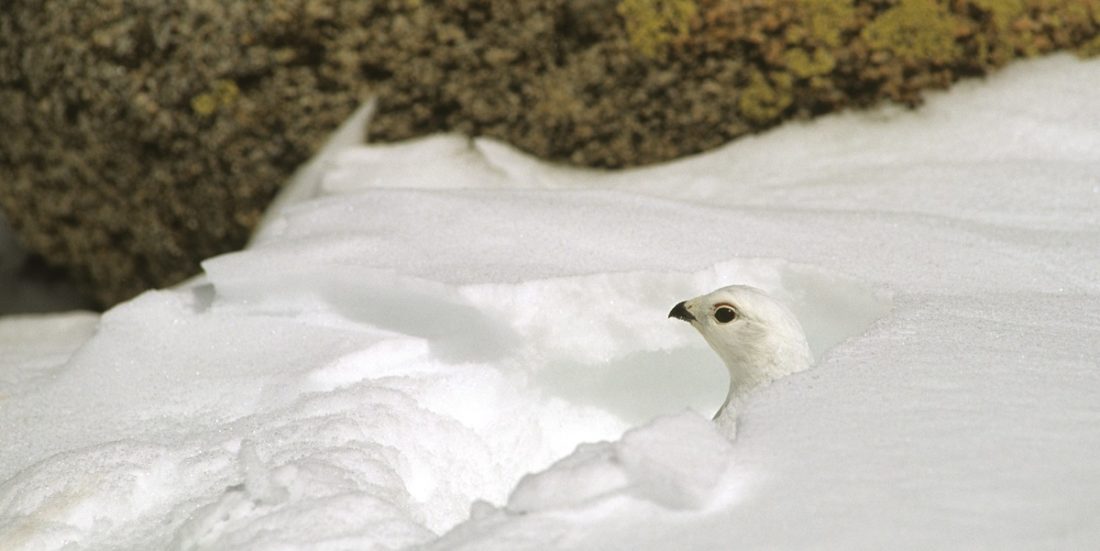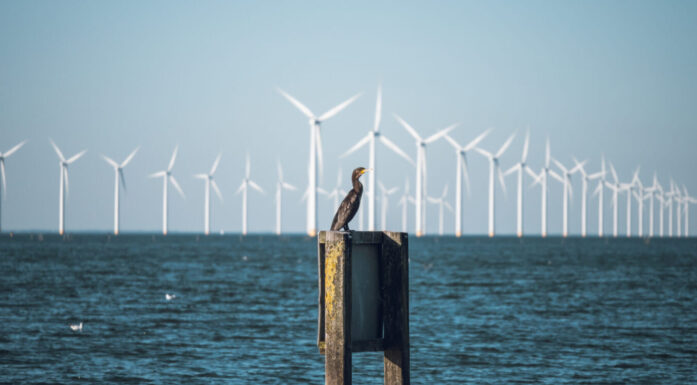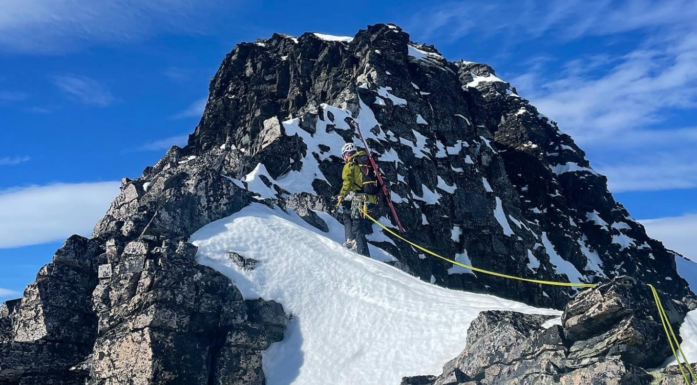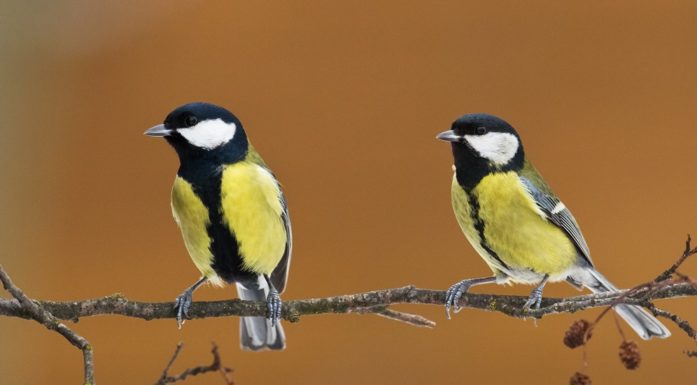Norwegian winter nights aren’t for sissies
Norwegian mammals and birds have many different methods of surviving long, intense winter nights.
For birds and animals that must live out in Norway’s frigid winters, every second has to be spent finding enough food not just to survive the day, but also the long hard night.
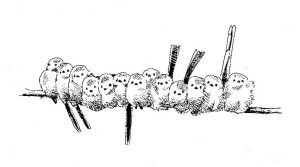
These long-tailed tits huddle together closely to keep warm. They sit side by side with puffed up feathers, looking like tiny feathered balls. The birds change places often, because getting to the middle is important— the birds on the outside are the ones that die first in the coldest temperatures. The dominant birds in the flock hierarchy squeeze down between the others, and thus have the greatest chance of surviving. (After Cramp & Perrins, 1993)
Not every creature manages to survive — it is not uncommon to find frozen birds in birdhouses after a winter cold snap.
Some creatures solve this problem by being inactive. Bears sleep and hedgehogs, bats, and the northern birch mouse all hibernate between October and April or May. But not every critter has this possibility.
Snow as an insulator
Surviving the cold is most difficult for small creatures— large mammals and birds can go up to several days without food.
Small creatures tend to have a large surface area compared to their total body size, which means that their bodies loose heat quickly when the cold sets in. They also aren’t able to store as much fat, which means less insulation and more heat loss. Surviving is all about preventing this heat loss.
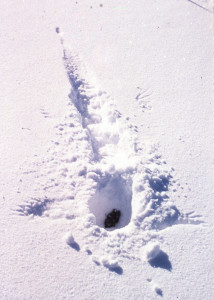
A willow ptarmigan’s nighttime burrow. When the bird leaves its shelter in the morning, it often leaves droppings behind. Photo: Olav Hogstad/NTNU
Norwegian game fowl, including wood grouse, black grouse, hazel grouse and willow ptarmigan, all choose to find shelter in snow caves or burrows at night, and when they rest during the day. Snow insulates very well, so these small caves are significantly warmer than if the birds were to sleep in the open.
Hazel grouse often spend their winter nights (and often days as well) in trees. During periods of intense cold, the birds dig down into the snow, where they stay to survive and protect themselves from the cold.
Small birds burrow too
The 13 cm long mealy redpoll uses the snow to stay alive through long winter nights as well. During intense cold, it digs a system of snow tunnels for shelter. If the snow is loose, it can just burrow straight down and make itself comfortable. If the snow is harder, it will dig down to between 6-11 cm below the surface, and then make a horizontal tunnel to spend the night in. In the morning, it emerges straight back up.
The Eurasian bullfinch also takes this approach. Snow insulates well, reducing the amount of heat lost by tiny bodies and minimizing the amount of energy spent surviving the night.
Small rodents such as voles and field mice also spend most of their winters in air pockets underneath the snow.
Sharing body heat is a life saver
One of Norway’s smallest birds, the tiny Eurasian wren, often groups together under the snow to survive nights, huddling tightly in groups of two or more. As many as 60 birds have been found together in England, piled on top of each other in several layers.
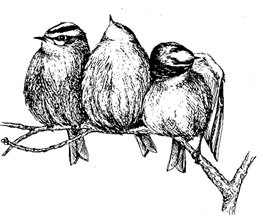
Norway’s smallest bird, the goldcrest, often spends winter nights in groups. These tiny five-gram birds huddle together, usually under branches or in small snow caves. Here, three birds have rather reluctantly grouped together— none of them appear to be particularly fond of this solution, with their beaks pointing out and away from each other. Illustration: Ellen Thaler
Eurasian treecreepers also sleep tightly grouped together, often in cracks in bark or in tree trunks under large branches.
Huddling together is undoubtedly incredibly important to staying warm. However, in all of the aforementioned cases, none of the birds seem to be particularly happy about the arrangement. There is often a lot of aggression within these groups, although cold does make the birds more docile. Surviving the night is most important. And you have to be thankful for what you’ve got.
Air pockets can be hard to find
To prevent heat loss through the course of the night, birds will try to find well insulated spots to sleep, such as an air pocket in the snow or a sheltered spot under a tree branch.
Woodpeckers peck out special holes to sleep in. These are not as well made as nesting holes, but do a good job of protecting the birds against the cold.
Many species of tits don’t make their own nests, which leads to a shortage of good places to sleep. Because of this, you can sometimes see great tits fighting over the best sleeping spots at twilight.
Slowed metabolism
Certain species of tits survive cold winter nights by slowing their metabolism and reducing their internal body temperature.
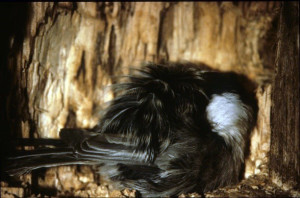
A willow tit in deep sleep in a small cave. It’s about 20 degrees below freezing outside. Its feathers are puffed up to create an insulating layer of air around its body, and it has stuck its beak into the feathers along its back, to avoid breathing in the freezing cold air. Photo: Gunnar O. Nilsen
During cold nights, willow tits can reduce their body temperature from the average 41 degrees to 31 degrees C, thereby drastically reducing damaging heat loss. The energy saved due to this can determine whether or not a bird survives. If a bird’s temperature goes down any more, however, it will die.
Willow tits have a finely tuned thermostat that tells the bird to start shivering when its core temperature reaches 32 degrees C. The action of shivering produces heat that allows the bird to stabilize its core temperature.
Cold spells are trying for Norway’s overwintering creatures. The long cold nights are the biggest challenges. And yet, they have survived, after thousands of years of finding different ways of adapting to this harsh environment.
Olav Hogstad is a professor emeritus at the Department of Natural History at the NTNU University Museum.
